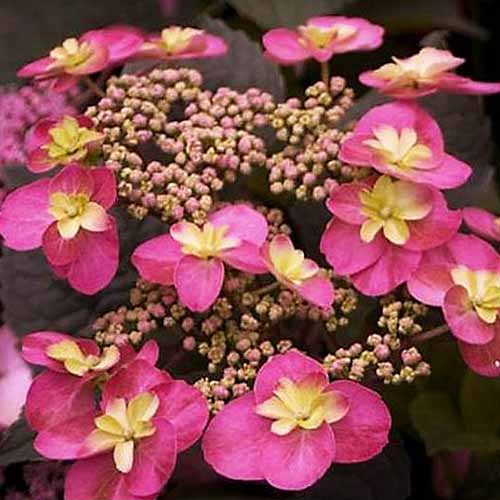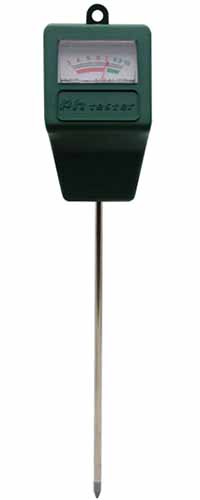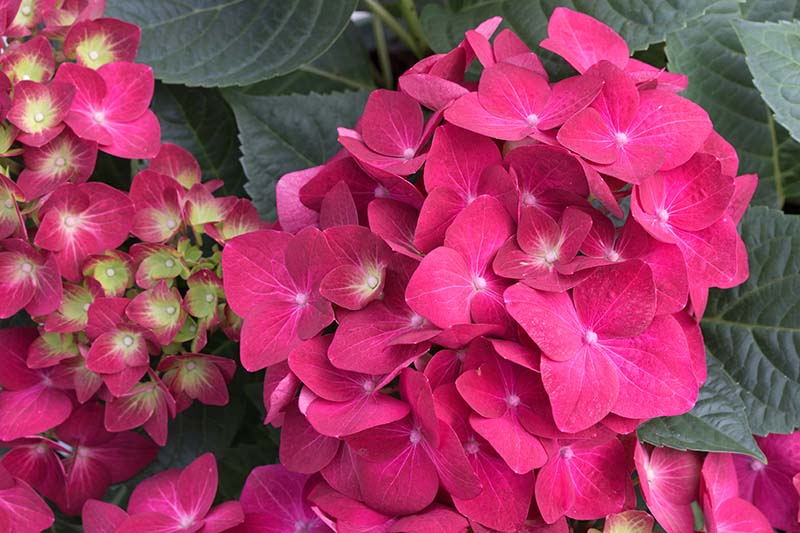With their large, attractive, and long-lasting flower heads, hydrangeas are wonderfully showy performers in the summer garden.

Fantastic in the landscape or as cut flowers, the bold blooms of the bigleaf varieties are a standout in vibrant shades of blue, green, mauve, pink, purple, red, and white.
And some of them have the seemingly magical ability to change the color of their flowers. From blue to mauve or pink and vice versa, their chameleon-like shifts are unique in the flower garden.
But it’s not magic, it’s just good old basic science. Because changing colors depends on the species you’re growing and the chemistry of your soil, not hocus pocus!
Keep in mind that changing their hue isn’t something that happens immediately. It can take several weeks or even months before you’ll see the desired effect, so a little advance planning (and some patience) will pay big dividends in juicy new flower shades!
Join us now to learn all about how to change hydrangea colors. Here’s what I’ll cover:
Hydrangea Basics
Hydrangea is a genus in the Hydrangeaceae family with approximately 80 species of flowering shrubs and vines.
But only two are notable for their color-changing abilities in the home garden:
H. macrophylla, the popular bigleaf species, particularly lacecap and mophead cultivars.

And H. serrata, also known as mountain hydrangea or tea of heaven.

The two species and their cultivars with changeable colors do so because of the acidity or alkalinity (pH) of the soil they’re grown in.
For the greatest chance of success, before you make any amendments it’s recommended that you allow your plant’s true colors to show over two growing seasons.
This also allows the roots to become well established before tinkering with the soil composition.
You may want to first experiment with compact, container-grown shrubs – it’s much easier and quicker to amend the soil in pots than in large garden beds.
When you purchase a plant that’s already in bloom, there’s no guarantee it will retain the same shade once it’s planted at home.

This makes the naming of many color-themed cultivars a fickle guideline. ‘Nikko Blue’ will turn pink when grown in more alkaline or neutral soil, and ‘Forever Pink’ produces blue flowers in more acidic soil!
And you also need to keep in mind that amendments are only a temporary fix. Once you stop adding them, the flowers will slowly return to their natural hue, as determined by the baseline pH of your soil.
For more cultivation information, be sure to read our guide on how to grow hydrangeas.
Cultivars to Select
When you are shopping, look for cultivars that can provide variable flower shades, which is usually indicated in the plant description.
And it’s helpful to remember that only two species can do this, H. macrophylla and H. serrata. Here are a couple of suggestions to get you started.
Bloom Struck
Selectively bred for an abundance of blooms, H. macrophylla ‘Bloom Struck’ features large, showy flowers that are blue, mauve, or pink depending on the soil pH.
Masses of attractive flowers appear in late spring with a steady reblooming throughout summer. Excellent as a summertime shrub or foundation plant, and for cut flowers.

‘Bloom Struck’
Plants grow three to four feet tall with a four- to five-foot spread and are hardy in Zones 4-9.
Plants in two-gallon pots are available at Home Depot.
Tuff Stuff Red
A red mountain hydrangea, H. serrata ‘Tuff Stuff Red’ has pretty bicolored blooms of deep, rosy pink and chartreuse. In acidic soils the blooms show as purple and blue.
The full-sized flowers cover the compact plants in early summer and reblooms through fall. Versatile and robust, plants are a standout in borders, containers, and shrubscapes and make an excellent cut flower.

‘Tuff Stuff Red’
Hardy in Zones 5-9, plants reach a mature height of two to three feet with a similar spread.
Plants are available for purchase in quart-sized containers at Nature Hills Nursery.
How to Change Colors
As mentioned, the soil pH determines the flower color. More specifically, it’s the presence of aluminum ions and the plant’s ability to absorb aluminum that impacts flower color.
If aluminum is present and available, as it is in more acidic soils, flowers are blue. In less acidic or neutral soils, the aluminum is combined with hydroxide ions, rendering it unavailable to the plant, and the flowers are pink.

Those plants with cream or white flowers are not affected by soil pH and don’t change color. Typically, they enjoy the same conditions as the pinks and reds.
For those cultivars with changeable flower shades, blues are best grown in soil with a pH of 4.5-5.5.
The intensity of the blue hue will depend on the precise pH of the soil. Closer to 4.5 will produce deep blue flowers, and they’ll turn more muted or violet-hued at a pH of 5 or 5.5.
The mauves, pinks, and reds need soil that’s less acidic or neutral, with a pH greater than 5.5, ideally between 6.0-7.0. The colors will be a more purple-pink around a pH of 6.0 and turn a more vibrant, bright pink closer to 7.0.
Before you start the task of amending the acidity or alkalinity of the soil, you’ll need to test it first. This will help you to determine exactly how much work is required to alter its pH.
You can take a pH reading at home with a simple meter, but for a comprehensive soil analysis, samples should be sent to a professional agricultural lab.
They can provide a detailed breakdown of which essential nutrients are present and also make recommendations on how you can improve the structure of your soil.

Bond pH Balance Tester
For an accurate, at-home pH meter reading, a Bond pH Balance Tester can be used in the garden and for house plants, available at Arbico Organics.
Alternatively, for a professional analysis, you can order a soil test from Arbico Organics. It’s simple to do, just dig out two cups of soil and place in a sealed plastic bag, and mail it in. Your results will be available two to three weeks later.
With some soils, it can be quite challenging to significantly alter the pH, and several applications may be required over the course of the growing season.
You’ll also need to keep in mind the needs of other plants growing in close proximity to your hydrangea before you make amendments to the soil.
Make sure you follow directions carefully when adding amendments, and be patient – your plant’s good health is the first priority.
For Blue Flowers
To change flowers from pink to blue, the soil needs to be acidified, or lowered on the pH scale, to between 4.5-5.5.

This is best done over the course of several weeks with the application of products such as aluminum sulfate, garden sulfur, or commercial soil acidifiers.
Aluminum Sulfate
To apply aluminum sulfate, in a watering can, mix one to four tablespoons with one gallon of water. Start in March, and soak the soil around the plant out to the dripline, then reapply in April and May.

Aluminum Sulfate
Four-pound bags of aluminum sulfate can be purchased at Nature Hills Nursery.
Garden Sulfur
Apply at the rate of half a cup per 10 square feet (one cup for heavy or clay soils). Use a garden fork to dig in the sulfur six to eight inches deep around existing plants, taking care not to damage the roots. Reapply annually.

Organic Garden Sulfur
You can find 50-pound bags of organic garden sulfur at Arbico Organics.
Soil Acidifiers
Made from a mixture of gypsum and elemental sulfur, Espoma social acidifier is an easy way to turn your pink hydrangeas blue.

Espoma Soil Acidifier
In spring, you simply spread the granules around the plant, and water in well, reapplying every two months.
You’d need one and a quarter cups for newly transplanted plants, and two and a half cups for established shrubs.
You can find Espoma soil acidifier available via Amazon.
Soil can also be acidified with the addition of specific organic composts, such as shredded conifer bark, conifer needles, oak leaves, peat moss, and sawdust. However, this is a much more gradual process and the results can be somewhat erratic.
It’s also helpful to amend planting sites with sphagnum peat moss. Add in a couple of shovelfuls when planting, or work in two to three inches of peat to a depth of six to eight inches in early spring.
Plus, an annual application of a low phosphorus, high potassium fertilizer, such as 25-5-30 (NPK) applied in spring is beneficial for blue flowers. High phosphorus fertilizers should be avoided as phosphorus binds aluminum in the soil, making it difficult for flowers to show blue.
Finally, hard water with a high mineral content can also affect the color, giving blue flowers a pink tone. If you have hard water, consider collecting rainwater instead.
For Pink Flowers
To change flowers from blue to mauve or pink, the soil needs to be made more alkaline, or raised on the pH scale, ideally between 6.0-7.0.
Garden Lime
The most efficient way to raise the soil pH is with the addition of garden lime. This also increases magnesium in the soil, an essential nutrient for photosynthesis and healthy green leaves.

Lime typically comes in grades such as granular, ground, and pelletized – ground and granular are the fastest acting for altering soil pH levels.
Lime needs time to work and is best when first applied in fall.
Add ground lime at the rate of 1/2 cup per 10 square feet and work into the soil, then water in well.
Wood Ashes
Wood ashes can also be used to raise pH, but it should be used sparingly – too much can burn foliage.
Every two to four years in winter, apply wood ashes directly to the soil at the rate of two pounds per 100 square feet. Test the soil after each application to monitor the results.
And in early spring apply a 25-10-10 fertilizer for pink blooms.
You can learn more about how to compost and use wood ashes in the garden in this guide.
Blue is the New Pink!
It takes a bit of work to change hydrangea colors, but the rewards can be quite fantastic!

Remember that blue flowers like acidic soil, with a pH of 4.5-5.5, and pink ones require a pH of 6.0-7.0.
Be consistent in adding amendments to the soil, test it regularly for accurate measurements, and then wait patiently – it can take several months for the changes to appear.
Do you folks have a favorite method for changing hydrangea flower colors? Tell us about it in the comments section below, and feel free to share a picture!
And for more know-how on growing hydrangeas, be sure to read these articles next:
© Ask the Experts, LLC. ALL RIGHTS RESERVED. See our TOS for more details. Product photos via Arbico Organics, Espoma, Home Depot, and Nature Hills Nursery. Uncredited photos: Shutterstock.
About Lorna Kring
A writer, artist, and entrepreneur, Lorna is also a long-time gardener who got hooked on organic and natural gardening methods at an early age. These days, her vegetable garden is smaller to make room for decorative landscapes filled with color, fragrance, art, and hidden treasures. Cultivating and designing the ideal garden spot is one of her favorite activities – especially for gathering with family and friends for good times and good food (straight from the garden, of course)!











.jpg)
